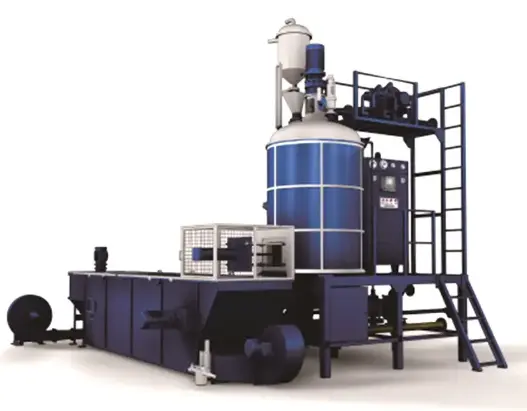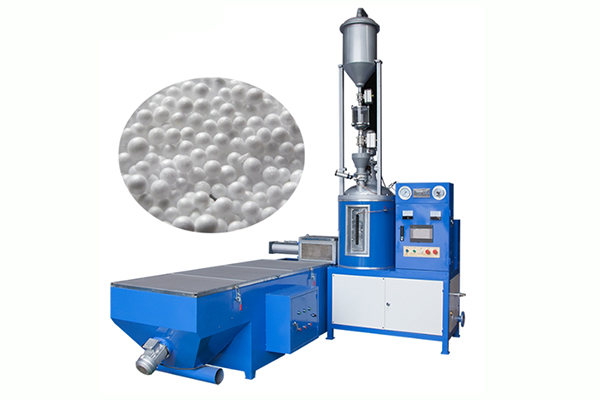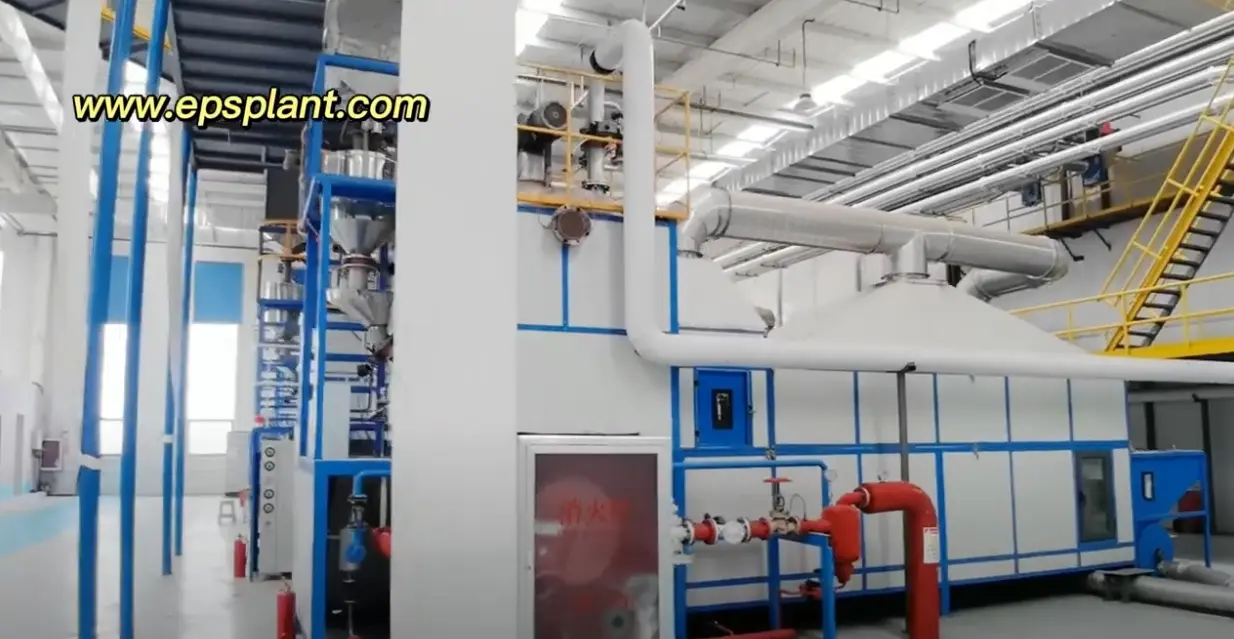Hello, my name is Allen. For over twenty years, my world has been the hum of machinery inside our factory here in China. As a manufacturer specializing in EPS and EPP foam machinery, I’ve stood at countless exhibitions, speaking with business owners and procurement officers like Mark Thompson from the USA. They’re sharp, decisive, and they don’t have time for fluff. They need to know how a piece of equipment will perform, how it will impact their bottom line, and if the supplier behind it is reliable. The most fundamental machine we discuss, the very starting point of all EPS production, is the EPS Batch Pre-Expander Machine. This guide is my direct answer to all the questions I’ve been asked. It’s an inside look from a manufacturer’s perspective, designed to give you the clarity you need to choose the right pre expander for your operations.
What Exactly is an EPS Batch Pre-Expander Machine and Why is it Essential?
The EPS batch pre-expander machine is the heart of any expanded polystyrene (styrofoam) production facility. It’s the very first, and arguably most critical, step in the entire process. This is the machine for eps that takes the tiny, solid beads of raw polystyrene and transforms them into the lightweight, expanded foam beads that will eventually become everything from protective packaging to large insulation block products. Without a high-performing pre expander, the quality of every single product down the line is compromised.
Think of it as the foundation of your house. If the foundation is weak, the whole structure suffers. Similarly, if your eps pre-expander produces beads with inconsistent density or uneven expansion, your final molding products will have defects. They might be too heavy, too brittle, or lack the required structural integrity. That’s why investing in a quality foaming machine isn’t just an option; it’s a necessity for any serious EPS production business. It ensures you start the process with a perfect base material, which is the key to manufacturing high-quality final goods and maintaining production efficiency.
How Does the EPS Batch Pre Expander Machine Turn Tiny Beads into Foam?
The process inside an eps batch pre expander machine is a fascinating application of physics. It all happens within a stainless steel expansion chamber. First, a precise amount of EPS raw material (the small, hard beads containing a blowing agent called pentane) is loaded into the chamber. This is often handled by an automatic vacuum feeding system. Once the beads are inside, the magic begins with the introduction of steam.
The steam serves two purposes. It provides the heating necessary to soften the polystyrene beads, making them pliable like soft plastic. At the same time, the heat causes the pentane gas trapped inside each bead to expand rapidly. This internal pressure forces the softened polystyrene to expand, much like popcorn popping. The bead can expand up to 50 times its original size! Throughout this process, an agitator inside the chamber keeps the beads moving to ensure they all receive uniform heat and expand evenly. Once the desired density is reached, the expanded beads are discharged into a fluidized bed dryer to cool and stabilize before being transported to silos for curing.
What’s the Difference Between a Batch Pre-Expander and a Continuous Pre-Expander?
When you’re looking at pre-expanders, you’ll see two main types: batch and continuous. Understanding the difference is key to choosing the right equipment for your specific needs. As the name suggests, a batch pre-expander machine processes the EPS beads in distinct, separate cycles or "batches." It loads a set amount of material, expands it, discharges it, and then starts the process over again. This method offers exceptional control over the final product.
A continuous pre expander, on the other hand, operates in a constant flow. Raw material is continuously fed into one side of the machine, and expanded beads flow out of the other. These machines are built for speed and are excellent for very high-volume production where a single, consistent density is required all day long.
Here’s a quick comparison:
| Feature | EPS Batch Pre-Expander | Continuous Pre-Expander |
|---|---|---|
| Control | Precise control over each batch; easy to adjust density. | Less flexible; designed for one target density. |
| Flexibility | Excellent for producing various densities, including high density foam. | Best for single-density, high-volume runs. |
| Application | Ideal for shape molding, lost foam casting, and varied block molding. | Perfect for large-scale insulation panel production. |
| Complexity | Simpler structure and often easier for maintenance. | More complex mechanics due to the continuous process. |
For most businesses that need the flexibility to produce different types of foam products, the eps batch pre-expander is the more versatile and logical choice.

What are the Key Components of a High-Quality Batch Pre-Expander Machine?
For a buyer like Mark, who is sensitive to quality, the internal components of a machine matter just as much as its overall performance. A machine is only as strong as its weakest link. Over my years of manufacturing, I’ve learned that using high-quality, internationally recognized components is the key to building a reliable and long-lasting eps machine. When you’re evaluating a china eps batch pre-expander, ask the supplier about the brand of its key parts.
A top-tier pre expander machine is composed of several critical systems. The electrical components are especially important. We insist on using parts from a famous brand like Schneider or Siemens for the main electrical elements and a sophisticated PLC (programmable logic controller) from a brand like Delta. The pneumatic valves that control the steam and air should be from a reputable source as well. This focus on quality components is a direct answer to a major pain point for buyers: inconsistent performance and frequent breakdowns. A machine built with quality parts simply runs better and lasts longer.
How Do You Achieve Precise Density Control with an EPS Pre Expander?
Achieving the correct density is everything in EPS foam production. The density of foam material determines its physical properties—its strength, its insulation value, and its weight. Inconsistent density leads to product failure and wasted material. This is where the precision of a modern batch pre expander machine truly shines. The key to this precision is a closed-loop control system.
The process starts with the electronic weighing system, which measures the exact amount of raw material for the batch. Inside the chamber, sensors constantly monitor the temperature and pressure. The most crucial part of the system is the material level control sensor. As the EPS beads expand, the volume they occupy increases. This sensor detects when the expanding foam has reached a certain level in the chamber, which corresponds to the target density. At that exact moment, the PLC shuts off the steam supply and discharges the batch. This automated feedback loop removes guesswork and ensures uniform beading and density from one batch to the next. This level of control allows you to consistently produce foam material within a very tight tolerance, which is critical for high-quality molding.
What is the Role of the Automatic Feeding and Weighing Component?
The front-end of the eps pre-expander machine—the feeding and weighing system—is foundational to its precision. Manual loading is slow, inaccurate, and simply not viable for modern production. An automatic system streamlines the entire process. It typically consists of a screw conveyor or vacuum feeder that transports the eps raw material from a storage hopper to the machine.
Before entering the expansion chamber, the material goes into a weighing unit. The electronic weighing system is integrated with the PLC. The operator simply inputs the desired batch size, and the system precisely measures out that amount of material. This precision is the first step in controlling the final density of foam material. An accurate weighing system ensures that every single batch starts with the exact same amount of raw material, which is essential for achieving consistent results. This automation doesn’t just improve accuracy; it also helps reduce labor costs and increases the overall capacity and throughput of your production line.

Can One EPS Batch Pre-Expander Handle Both First and Second Foaming?
Yes, a versatile eps batch pre expander machine is designed to realize first and second foaming. This is a critical feature for producers who need to manufacture foam products with a very low density or very high density. "First foaming" is the standard expansion process we’ve been discussing. However, sometimes you need to expand the beads even further or achieve a very specific density that’s difficult to reach in a single pass. This is where "second foaming" comes in.
After the first expansion, the beads are allowed to cure and stabilize for a period. Then, this already expanded material is fed back into the pre expander for a second, gentler expansion cycle. This process allows you to achieve much lower densities (lighter foam) than is possible in a single stage. Conversely, for high-density applications like lost foam casting, this two-stage process can create a more stable and uniform bead structure. A single machine that can handle first and second foaming respectively offers incredible flexibility, allowing you to produce a wider range of polystyrene products and meet diverse customer demands.
How Does Steam Pressure and Temperature Control Impact Foam Quality?
The quality of your steam is a silent but powerful factor in the quality of your foam. Effective control on temperature and pressure of the steam is non-negotiable. You need a steady supply of dry, saturated steam at a consistent pressure. If the steam is too "wet" (containing too much water condensate), it will transfer heat unevenly and can cause the beads to clump together. If the pressure fluctuates, the expansion will be inconsistent.
A well-designed eps batch pre-expander machine incorporates high-quality pressure-reducing valves and gauges to ensure the steam entering the chamber is precisely what’s needed for the target density. The machine’s PLC controls a sophisticated valve system to manage the flow of steam with incredible accuracy. This precise temperature control and pressure management ensures that every bead in the batch receives the optimal amount of energy for uniform expansion. This results in the superior beading and density of foam that is the hallmark of a quality product.
What Should You Look for in a Manufacturer and Supplier in China?
For a buyer in the USA or Europe, sourcing machinery from China is a smart financial decision. However, it comes with its own set of concerns, which I hear about all the time. My advice is to look beyond the price tag and evaluate the manufacturer themselves. You are not just buying a machine; you are starting a long-term partnership.
First, look for a genuine factory, not just a trading company. A real manufacturer has the technical expertise to support you and can provide spare parts directly. Second, communication is key. Your supplier should have a professional, English-speaking team that can answer your technical questions clearly and promptly—this directly addresses a major buyer pain point. Third, ask for proof. Request customer references, case studies, and video demonstrations of their equipment in action.
Finally, discuss after-sales service and warranty upfront. A reputable supplier in China will offer a comprehensive warranty and provide support for installation and training. As a Professional EPS Machine Manufacturer, we have built our business on these principles. We understand that our success is tied to our customers’ success, and we are committed to being a reliable partner, not just a one-time supplier.

How to Integrate Your Pre-Expander into a Full EPS Production Line?
The pre expander is the starting point, but its true efficiency is unlocked when it’s seamlessly integrated into a complete production line. A well-designed workflow minimizes manual labor, reduces material handling time, and maximizes output. After the foam beads are expanded and dried, they are typically transported via an air conveying system to large storage silos.
These silos allow the beads to cure and stabilize before they are sent to the next stage, which is usually molding. From the silos, another conveying system automatically delivers the appropriate beads to either an EPS Block Moulding Machine for producing large blocks or an EPS Shape Moulding Machine for creating custom products like helmets or packaging corners. Integrating all this equipment with a centralized control system like an Automatic EPS Silo System creates a highly automatic and efficient production powerhouse. This system-level thinking is what transforms a collection of machines into a lean, profitable manufacturing operation.
Key Takeaways for Your EPS Batch Pre-Expander Investment
Choosing the right foaming machine is a foundational decision for your business. It sets the standard for the quality and efficiency of your entire EPS production process.
- The Pre-Expander is Critical: It is the heart of your operation. The quality of your expanded beads determines the quality of your final products.
- Batch Offers Flexibility: An EPS batch pre-expander provides the precise control needed to produce a wide range of foam densities, making it ideal for most applications.
- Quality Components Matter: Insist on a machine built with components from reputable, famous brands. This ensures reliability and minimizes downtime.
- Automation is Key: Features like automatic feeding, weighing, and density control are essential for consistent quality and high production efficiency.
- Choose a True Partner: Look for a manufacturer from China who is a genuine factory, communicates clearly, and offers strong after-sales support and a solid warranty.
Post time: 11-20-2025





